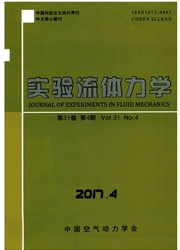

 中文摘要:
中文摘要:
运用PIV技术对充分发展的水平槽道内稀疏湍流两相流中的颗粒行为进行了定量研究。实验中壁面雷诺数Rer=430,使用颗粒为直径60μm的聚乙烯微珠,测量了0.1%和0.5%两种质量荷载。研究发现,颗粒最大浓度出现在y+≈10的位置上。对两种质量荷载,下壁面附近的颗粒体积分数最大值均远小于10^3量级,仍属于稀疏两相流。槽道下壁面附近,向上运动的颗粒概率大于向下运动的颗粒,两者概率的差异随着法向距离的增大而减小。在y’=10~30的范围内,颗粒相“喷射”事件(Q2)和“下扫”事件(Q4)概率分别显著地大于和小于当地流体对应值。颗粒相主要通过促进Q2且抑制Q4来实现对流体湍流的影响,颗粒的这一作用随着法向距离的增加而逐渐减弱。
 英文摘要:
英文摘要:
Experimental investigation on the particle behavior of two phase turbulent flow in fully developed horizontal channel was conducted using PIV technique. The wall Reynolds number RG : 430. Polythene beads with diameter of 60μm were used as particle phase, two mass loading ratios of 0.1 % and 0.5 % were tested. It was found that the maximum particle concentration occurs at y+ ≈10. The maximum particle volume friction is far smaller than 10 ^-3 for the two mass loading ratios, indicating that the flow is still dilute near the bottom wall. The probability of particles moving upwards is bigger than that of particle moving downwards near the wall. The difference between these two probabilities becomes smaller with increasing y+. At y+= 10-30, the probabilities of "Ejection" (Q2) and "Sweep" (Q4) for the particle phase are significantly bigger and smaller than those for the fluid, respectively. The turbulence modulation caused by the particle phase is mainly related to the increased Q2 and suppressed Q4, and this observation becomes less obvious with increasing distance from the bottom wall.
 同期刊论文项目
同期刊论文项目
 同项目期刊论文
同项目期刊论文
 Effects of aspect ratio on the drag of a wall-mounted ?nite-length cylinder in subcritical and criti
Effects of aspect ratio on the drag of a wall-mounted ?nite-length cylinder in subcritical and criti 期刊信息
期刊信息
